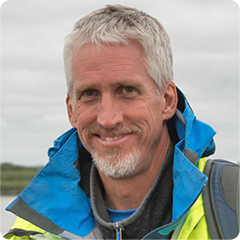The Arctic Ocean is the most landlocked ocean on Earth, and runoff from the pan-arctic watershed exerts strong control over ocean circulation and biogeochemistry. This project investigates the linkage between hydrologic variables and the fluxes of nutrients and organic matter (constituents) from the North Slope of Alaska to the Alaskan Beaufort Sea. The overarching goal of the work is to develop a generalized understanding of discharge-constituent relationships in arctic basins. The primary question is: What are the relationships between discharge and constituent concentrations in the three largest North Slope basins (Kuparuk, Colville, and Sagavanirktok) and have these relationships changed over the past 25 years of rapid warming in the Arctic? Three sub-questions that emphasize specific spatial and temporal components of the primary question are: 1) What are the contemporary fluxes of carbon, nitrogen, and phosphorous (C, N and P) from the three largest North Slope basins to the Alaskan Beaufort Sea? 2) How do discharge- constituent relationships differ among the three basins? 3) How do the discharge-constituent relationships over the past 25 years inform us about future changes?
To address these questions, the group take advantage of extensive data collected in the Kuparuk River as a core part of the Arctic LTER project. Researchers have been actively involved in gathering nutrient and organic matter data and recording discharge in the Kuparuk River since the late 1970s. The team will use these data to define discharge-constituent relationships over the open-water season and to develop transfer functions for use with an existing hydrologic model to estimate contemporary and long-term constituent fluxes from the Colville and Sagavanirktok river basins. This approach is necessary because we lack sufficient historical data on the Colville and Sagavanirktok for a direct analysis. Estimates of contemporary fluxes will be compared to measurements made on the Sagavanirktok and Colville rivers during Year 2 and Year 3 of the project. The generalized discharge-constituent transport relationships that will be defined are needed to synthesize information now being collected at many locations and at many scales.
Update: Year 2 (May to August, 2006) of the project was an intensive field campaign in the Kuparuk, Colville, and Sagavanirktok basins. Dissolved and particulate constituents were sampled at the mouths of the three rivers and in the Kuparuk headwaters. The Colville and both Kuparuk sites were sampled during the time of the initial ice break-up in May. This is a critical time because it is often the highest part of the hydrograph all year, and it is the time when the concentrations of many constituents (such as dissolved and particulate organic matter, sediments, and some nutrients) are also highest. Concentrations of all constituents and discharge measurements will be used to model fluxes over the entire season to the Arctic Ocean.
Project Location
Journal Publications
Townsend-Small, A., McClelland, J.W., Holmes, R.M., and B.J. Peterson, "Seasonal and hydrologic drivers of dissolved organic matter and nutrients in the upper Kuparuk River, Alaskan Arctic", Biogeochemistry (2010), doi:10.1007/s10533-010-9451-4.
Frey, K.E. and J.W. McClelland, "Impacts of permafrost degradation on arctic river biogeochemistry", Hydrological Processes 23:169-182 (2009).
Dates
-Members
Lead Principal Investigator
Principal Investigator

Principal Investigator
Principal Investigator

